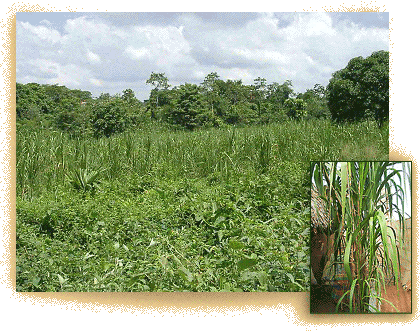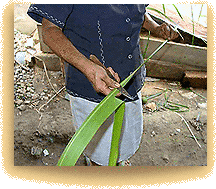
| 
|
and Caņaflecha production
The forests of South America are rapidly disappearing, yet contain
some of the highest biodiversity in the world. War-torn Colombia is
the home of some of the most biologically diverse plant and animal
communities we know, hosting numerous micro-climates and endemic
species.
Unique Geography
Colombia lies at the confluence of three giant eco-regions (the Central American Corridor, Andean-Amazonian Interface, and the Pacific, Tropical Andean Interface). As one travels, starting from the coast on the west or Amazon basin in the east, up to the heights of the Andes mountains, the temperature, rainfall, and climate change rapidly. Within a few hundred meters, one can find a diversity of species adapted for different areas.
This diversity is reflected in the incredible number of natural fibers used by indigenous artisans and communities from the many unique regions of these countries.
Difficult Problems
Sadly, much of these natural areas and their unique indigenous cultures are rapidly disappearing due to poor development policies, government corruption, war, overpopulation, abject poverty, and deforestation.
Many of the areas where these crafts are made have been severely impacted by the global war on drugs and "terrorism."
The countryside around our sources is characterized by rolling hills, now covered with eroded clay and alluvial soils. This land has been dramatically affected by human activities like the clearing of native vegetation and trees for pasture and agriculture. Heavy tropical rains leach nutrients from cleared land, and, during dry periods, the strong equatorial sun bakes the exposed soil.
A Possible Solution
Craft development, like our importing of fairly-produced caņaflecha bags and hats, may provide some assistance in finding alternative sources of income, while creating incentives to maintain the natural forest from which the fibers are harvested. Of many areas around the world, Colombia may have a greater chance to protect and build sustainable livelihoods because of its large and growing middle-class, its educational system that is one of the best in Latin America, and existing and improving infrastructure for business and development.
Caņaflecha (Gynerium sagitarum) fiber is a highly utilitarian, renewable product. The fiber and crafts made from it play an important role in rural economies and sustainable development. The cane-like grass species is found naturally in lowland Amazonian regions primarily in areas of disturbance. As a native plant, it is a better agricultural crop than imported, non-native species that may require expensive inputs, like fertilzer, pesticides or irrigation.
Currently, caņaflecha is grown commercially in a specific lowland ecosystem in the coastal plain of Cordoba, Colombia near the northern Caribbean coast. It is uncertain if caņaflecha crafts are produced in other areas of what seems to be a widely distributed species range.

above, a caņaflecha field and an individual plant
How our caņaflecha products are made
The Raw Materials
Caņaflecha, a cane-like plant, grows wild, is easily propogated, and matures in only six months. Seedlings are planted with a stick during the rainy season when the soil is wet. The fiber is harvested by rural families, and then is either woven into value-added crafts or sold to other artisans to make into finished goods. Demand is rapidly increasing for the fiber, and this has been reflected in the raw material price.
Fiber Preparation
removing the vein from the leaf
scraping the vein |
The artisans use only the inner vein of the leaf of the plant, cutting away the sides. After removing the vein from the rest of the leaf, they scrape it and then dry the fiber in the open sun. The artisans then cut the inner vein into different widths, according to their requirements -- the narrower the fiber, the finer the final quality of the braid. The quality can also be improved by finer scraping (cleaning) of the palm or by soaking it in water with lemon juice. | |
dried caņaflecha fibers |
Dyeing
The fiber used in weaving can be either dyed or un-dyed (natural white to light tan color). Natural plant dyes are used to make five or six additional colors: a dark brown to black, coffee (tan), red, yellow and green. Usually, the dying process entails soaking the fiber in mud. The commonly used black color is achieved by soaking the fiber in a pot of mud overnight, then boiling it together with a red dye from the "ija" plant. This process is repeated three times to obtain the dark brown to black color.
Other dye colors include: red, obtained just by boiling the natural fiber with "vija" leaves; tan, by boiling with coffee grounds; and a green color, by soaking the fiber in mud and then boiling it with "singraretila". These natural dyes will fade in strong sunlight over time, though they do not run. No effort is apparently made to fix the colors, except for the mud bath, which may contain minerals that act like salt, used to fix most natural dyes in other natural fiber textile industries.
Braiding

braiding caņaflecha
Next, the artisans braid the dyed and un-dyed fibers into lengths or strands. Artisans often braid the fiber into the traditional "rice-flecking" pattern, contrasting natural fiber with dyed.
The finished product's quality is determined by the width and number of fiber pairs braided.
 |
 |
Artisans also weave single-color braids used to make a solid or banded look. Additional weaves are available and become quite elaborate as exemplified by the jewelry and fine hat products.
Braids are then sewn into finished goods, either using simple sewing machines or by hand.




